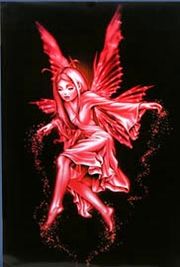Red Fairies #1: The Fairy Bandits? February 2, 2016
Author: Beach Combing | in : Medieval, Modern , trackback
Imagine the scene: 1555, Lewis Owen, vice-chamberlain is passing down the road with a small bodyguard and his son-in-law, on the edge of Powys in central Wales. As they pass down the track, they come to several felled trees across their way in the midst of ‘thick woods’. Are the men anxious? Perhaps not at first, but then the arrows begin and they are followed by javelins and bills… Within minutes all of Lewis Owen’s party had fled or had been killed, with their master, who fell to the floor with thirty wounds in him.
In one respect this bloody incident is just another internecine Welsh feud. Lewis Owen had been the judge who had sentenced some eighty outlaws to death and this was the clan’s revenge. It would be followed by bloody reprisals on the part of the English crown: Lewis Owen had been their agent and his death could not go unpunished. But there is something that brings this attack out of the ordinary and rank list of ambushes and bloody slaughter. A number of intelligent people have in the last century suggested or implied that the men who opened fire on Lewis Owen were fairies.
The basic justification for this belief is that the men who did the killing on this occasion were called the Gwilliaid Cochion Mowddwy; ‘the Red Fairies of Mowddwy’. There have been three ways to parse this unlikely sounding information. First, this was just a cool gang name: Lewis Owen’s enemies did not have wings. Second, some sixteenth-century thugs somehow got mixed up with fairies in the popular imagination: they lived in the wood, they killed people… Third, these were Welsh sasquatch, a race of Neolithic relicts that caused hell in the neighbourhood. To the best of Beach’s knowledge no one has suggested that these were actually immaterial we-love-flowers-and-trees fairies, but it is only a matter of time. In a short series of posts on the Gwilliaid Cochion Mowddwy Beach will examine the claims and the arguably quite simple solution to this problem. The posts will be split into four:
Today’s post
Y Gwilliaid Cochion and Ethnicity
Y Gwilliaid Cochion and Folklore
Y Gwilliaid Cochion and Language
Any general comments will be placed under this post. More specific ones under the proper headings.
The tag will be the Red Fairies. Below here is perhaps the single most important written source on the Red Fairies: some words from Thomas Pennant’s very influential A Tour in Wales (1778). It is the earliest extensive source in English or Welsh and it is, note, two hundred years too late!
[83] Return to Dinas y Mowddwy. On the road was informed of the place, not far from hence, where Lewis Owen, vice-chamberlain of North Wales, and baron of the exchequer of North Wales, was cruelly murdered in the year 1555, by a set of banditti, with which this country was cruelly overrun. After the wars of the houses of York and Lancaster, multitudes of felons and outlaws inhabited this country; and established in these parts, for a great length of time, from those unhappy days, a race of profligates, who continued to rob, burn, and murder, in large bands, in defiance of the civil power; and would steal and drive whole herds of cattle, in mid-day, from one county to another, with the utmost impunity. To put a stop to their ravages, a commission was granted to John Wynn ap Meredydd, of Gwedyr, and this gentleman, in order to settle the peace of the country, and to punish all offenders against its government. In pursuance of their orders, they raised a body of stout men, and on a Christmas Eve seized above four score outlaws and felons, on whom they held a jail delivery, and punished them according to their deserts. Among them were two sons of a woman, who very earnestly applied to Owen for the pardon of one: [84] he refused; when the mother, in a rage, told him (baring her neck) These yellow breasts have given suck to those, who shall wash their hands in your blood. Revenge was determined by the surviving villains. They watched their opportunity, when he was passing through these parts from Montomeryshire assizes, to way-lay him, in the thick woods of Mowddwy, at a place now called, from the deed Llydiart y Barwn; where they had cut down several long trees, to cross the road, and impeded the passage. They then discharged on him a shower of arrows; one of which sticking in his face, he took out, and broke. After this, they attacked him with bills and javelins, and left him slain, with about thirty wounds. His son-in-law, John Llwyd of Ceisgwyn, defended him to the last; but his cowardly attendants fled on the first onset. His death gave peace to the country; for most rigorous justice ensued; and the whole nest of banditti was extirpated, many by the hand of justice; and the rest fled, never to return.
The traditions of the country respecting these banditti, are still extremely strong. I was told that they were so feared, that travellers did not dare go the common road to Shrewsbury, but passed over the summits of the mountains, to avoid their haunts. The inhabitants placed scythes in the chimneys of their houses, to prevent the felons coming down to surprize them in the night; some of which are to be seen to this day. The race was distinguished by the titles Gwyllied y Dugoed, and Gwilliaid Cochion Mowddwy, i.e. the Banditti of the Black Wood, and the red-headed Banditti of Mowddwy.


